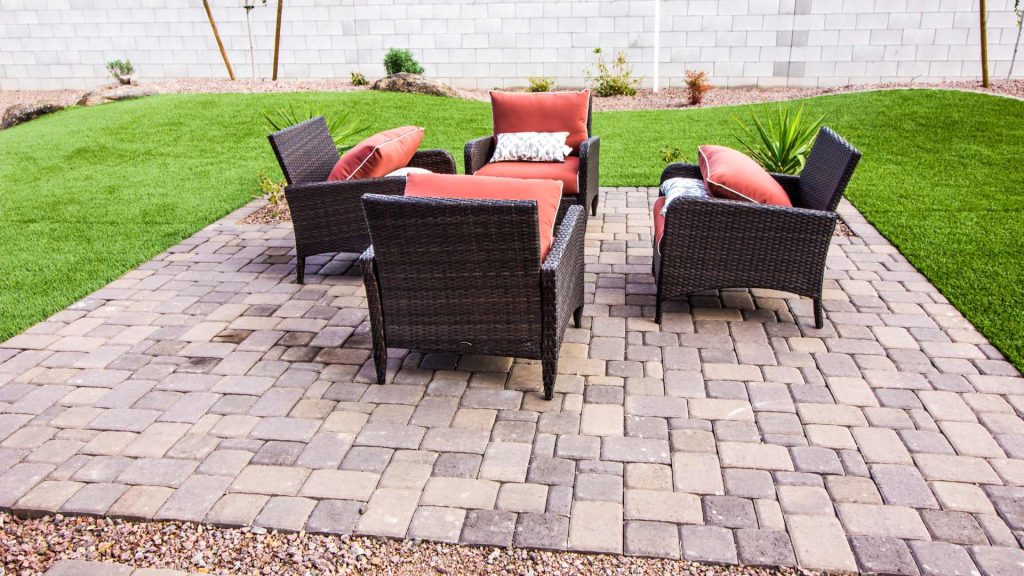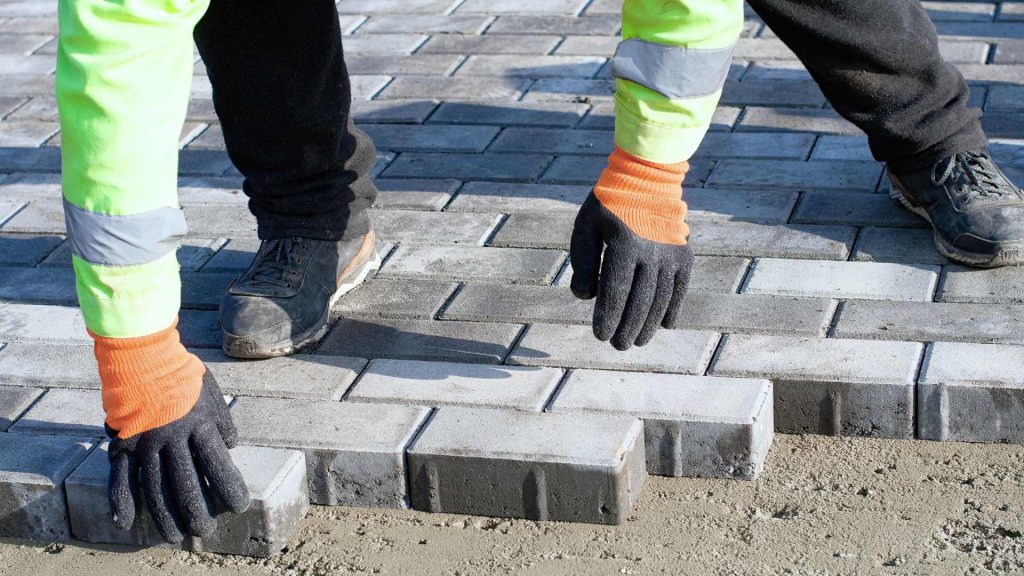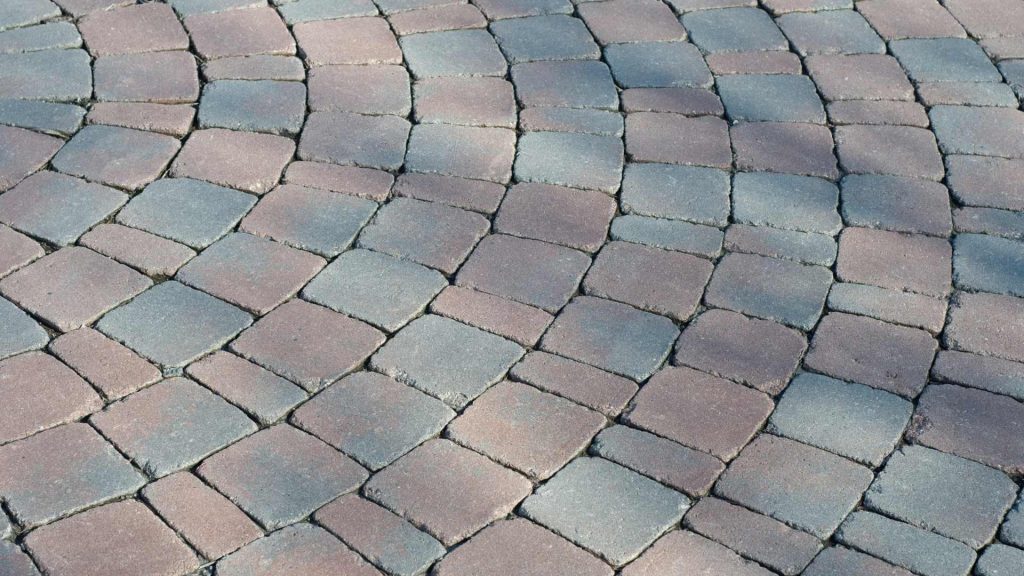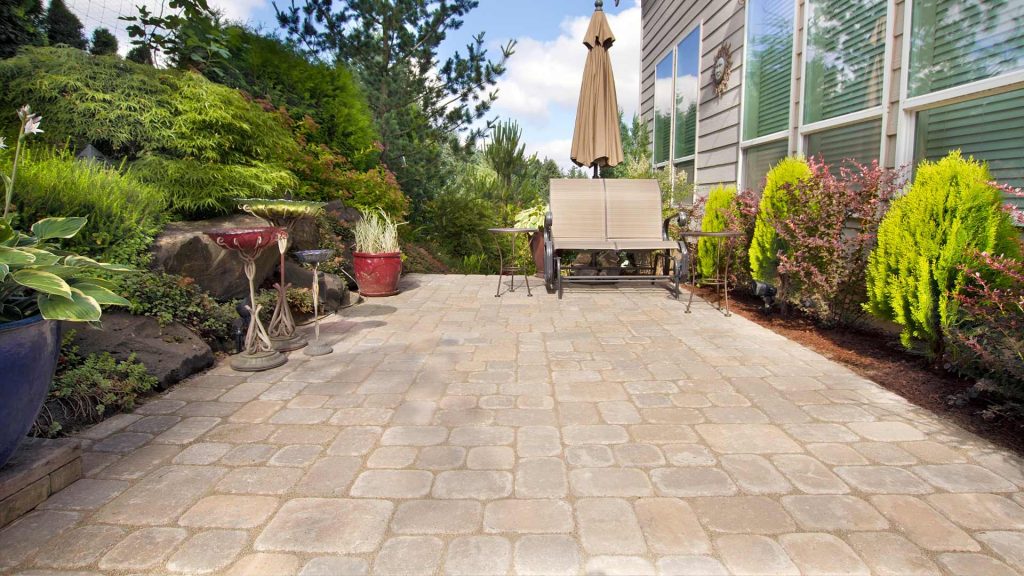Why a Calendar Beats “Fix It When It Breaks”
Our sun, salt air, sandy soils, and summer downpours can age hardscapes fast if you only react to problems. A simple, proactive month‑by‑month routine keeps your driveway, patio/lanai, walkway, and pool deck clean, safe, and great‑looking while preventing costly repairs. This calendar is tailored to Collier County conditions and works for travertine, porcelain (outdoor‑rated), and concrete pavers.
What You’ll Need (Keep This Small Kit Handy)
- Leaf blower or soft‑bristle push broom (for sand/debris).
- Garden hose with adjustable nozzle; neutral pH cleaner safe for your material.
- 5‑gallon bucket, soft deck brush, and a microfiber mop for finishes.
- Polymeric sand (matching color) for top‑ups; rubber mallet and plate compactor with a pad if doing larger areas.
- Non‑slip additive (if you plan to reseal stone/concrete near water).
- Paver‑safe stain removers for rust/tannins and efflorescence cleaner (as needed).
- Replacement edge spikes or screws if you ever need to re‑secure edge restraint.
Safety note: Avoid harsh acids on travertine and avoid coating porcelain faces with film‑forming sealers; seal the joints only on porcelain.

Month‑by‑Month Paver Care
January — Rinse & Reset After Holidays
Start the year clean. Blow leaves and sand from joints, then rinse. Spot‑clean oil or rust on driveways before they set in the sun. On travertine, use a stone‑safe neutral cleaner. On concrete pavers, a light scrub lifts any tire marks.
Goal: Clear debris; baseline inspection for low joints and loose edges.
Tip: Cool, dry days = ideal for reseals if you want a fresh look before spring.
February — Inspect Joints & Edge Restraint
Walk all edges: pool deck coping, lanai thresholds, and driveway borders where turning loads bite. If you see joint loss, plan a polymeric sand top‑up this month.
Goal: Mark repair zones; schedule sand refresh while humidity is lower.
Pro move: Photograph any birdbaths (low spots) after light rain and flag them for re‑leveling.
March — Deep Clean Before Peak Use
Time for a seasonal clean. Rinse, apply neutral cleaner, agitate with a soft brush, and rinse again. Avoid blasting joints; keep nozzles wide and pressure modest. Treat any efflorescence on concrete pavers per product directions before resealing.
Goal: Clean surfaces and restore traction ahead of spring guests.
Pool decks: Remove sunscreen build‑up to maintain slip resistance.
April — Polymeric Sand Refresh (If Needed)
Warm days and fewer pop‑up storms make April prime for joint maintenance. Dry the surface thoroughly, sweep in sand diagonally, compact (with protector mat), sweep residue, then light‑mist activate per the label. Protect from rain during curing.
Goal: Lock joints against weeds, ants, and washout before storm season.
Where first: Downspouts, step edges, driveway turn‑ins, and open edges.
Interlink (Blog): Link “polymeric sand in SWFL (installation steps)” to the polymeric‑sand post.
May — Drainage Tune‑Up
Clear catch basins, channel drains, and pop‑ups. Verify water sheds away from lanai sliders and door thresholds. Add permeable relief bands along low patio edges if you’ve had puddling.
Goal: Make water your ally, not your enemy, before June rains.
Bonus: Reset or add edge restraint where you see creep.
June — Storm‑Season Kickoff Checklist
We’re officially in the wet months. After the first heavy rain, walk every surface. Top up joints that dipped, and confirm drains flow. Trim vegetation touching pavers; leaves + standing water = stains.
Goal: Prevent washout channels and protect weak spots early.
Pro move: Keep rain tents/tarps on hand if you’re mid‑project.
July — Mid‑Storm Monitoring
Expect afternoon storms. Rinse grit off pool decks so it doesn’t scour joints. Check driveway aprons where street runoff can back‑flow. If you see a new birdbath, mark it; we can lift and re‑level a small panel after the season.
Goal: Keep joints tight and surfaces safe during peak rain.
Safety: Watch for algae/film in shaded walkways; neutral clean as needed.
August — Salt & Sun Management
Salt spray and sunscreen stains are most obvious now. Porcelain faces: neutral clean only. Travertine & concrete: neutral clean; plan for a breathable penetrating reseal if water stops beading and colors look flat.
Goal: Protect stone/concrete from salt and UV; keep porcelain joints clean.
Pool decks: Consider non‑slip additive when resealing stone/concrete.
September — Post‑Storm Audit & Spot Fixes
As storms taper, do a fuller audit. Flush basins, clear pop‑ups, and inspect edges. If you had joint washout, repeat polymeric sand in those small zones.
Goal: Stabilize everything before the busy fall season.
Permeable pavers: Vacuum or rinse the surface to restore infiltration.
October — Reseal Window (Stone/Concrete)
This is the Goldilocks month: lower humidity, less rain, still warm. If your last seal was 2–3 years ago (stone/concrete), now’s the time. Choose breathable penetrating for travertine; on concrete, pick penetrating (natural) or a matte film‑forming for color pop with non‑slip on slopes.
Goal: Refresh protection ahead of holiday entertaining.
Porcelain: Seal joints only; tile bodies generally don’t need sealer.
November — Edges, Steps & Lighting
Check step nosing, coping adhesion, and edge restraint after storm season. Tighten, re‑adhere caps with flexible adhesive, and confirm path lighting works for earlier sunsets.
Goal: Safety and polish.
Style: Wipe mineral spots with paver‑safe cleaners for holiday photos.
December — Holiday‑Ready Clean & Future Plan
Final rinse and blow‑down. Spot‑clean driveways where deliveries or guests park. Make a note of your reseal date, last sand refresh, and any areas to re‑level next year.
Goal: Start the new year with a clean slate and a simple checklist.
Pro move: Book a January or February service window before schedules fill.

Material‑Specific Tips for Homes
Travertine
- Use breathable penetrating sealer (natural or enhancing) on a 2–3 year cycle.
- Avoid harsh acids; if you need stain removers, choose stone‑safe formulas.
- Keep tan polymeric sand flush to the surface to support edges and stop weeds.
Porcelain (Outdoor‑Rated)
- Clean with neutral pH; no wax or film on the tile face.
- Seal joints only; select a fine‑grain polymeric sand for narrow joints.
- Verify traction ratings (DCOF) near splash zones; keep sunscreen buildup off.
Concrete Pavers
- Reseal every 2–3 years; choose UV‑stable products to avoid yellowing.
- If you like a richer tone, consider a matte film‑former with non‑slip on slopes.
- Treat efflorescence before sealing; don’t seal it in.
Driveways, Pool Decks, Patios & Walkways — What Changes?
Driveways: Turning loads and hot tires stress borders and joints. Inspect aprons and turn‑ins quarterly; top up sand more often here. If you notice puddling after heavy rain, consider permeable bands near the apron.
Pool Decks & Lanais: Focus on traction and salt/sunscreen management. Keep joints proud and flushed; schedule sealing with non‑slip where appropriate.
Patios: Furniture scuffs and planters can trap moisture. Use saucers or gravel pads beneath planters to prevent ring stains.
Walkways: Algae in shade is common . Rinse more frequently and use neutral cleaners to keep surfaces safe.

After‑Storm Micro‑Checklist (Any Month June–October)
- Rinse & blow debris so it doesn’t dry into joints.
- Open drains: clear channel grates and pop‑ups; flush basins.
- Top up joints where you see dips; re‑activate polymeric sand.
- Check edges for creep; re‑secure edge restraint if needed.
- Mark birdbaths for a later lift & re‑level service.
What About Permeable Pavers?
Permeable systems love rain. Keep the surface vacuumed/rinsed yearly so infiltration stays high. Do not fill open joints with standard polymeric sand; use manufacturer‑approved aggregates. If the patio sits under heavy tree litter, plan quarterly cleanups to prevent clogging.
Common Mistakes (and Easy Fixes)
- Blasting with high pressure: This can gouge bedding sand and eject joint material. Use the lowest effective pressure and a wide fan tip.
- Sealing too soon or in high humidity: Moisture traps cause whitening. Wait for a steady dry window.
- Skipping joint compaction: Surface‑only sand won’t last through summer rains. Compact and top up to full depth.
- Wrong products on the wrong material: Film‑formers on travertine or porcelain faces cause slip and haze. Stick to the right chemistry per material.
- Letting downspouts dump on pavers: Tie into drains or add splash blocks that land on stone—never on joints.
Real‑World Examples
- Park Shore Pool Deck: Quarterly neutral cleaning + tan polymeric sand top‑up at splash edge. Result: non‑slip deck and crisp joints despite heavy use.
- Park Driveway: Annual joint inspection and permeable bands added near the apron. Result: no puddles even after summer downpours.
- Golden Gate Estates Patio: Resealed in October with a breathable penetrating product; winter guests compliment the natural stone look and quick dry‑out after showers.
FAQs
How often should I reseal in ?
For travertine and concrete, expect every 2–3 years depending on sun and traffic. Porcelain body usually doesn’t need sealer; joints do.
Can I use a pressure washer?
Yes, with care. Keep pressures moderate, tips wide, and distance safe. Avoid hitting joints directly; top up polymeric sand if you see washout.
What if weeds are already showing?
Remove them, clean the joint, and refresh polymeric sand to full depth. Consider a reseal cycle to lock everything in.
My pool deck feels slick—what now?
Neutral clean to remove sunscreen film. If resealing stone/concrete, add non‑slip and choose matte finishes. Verify DCOF ratings on porcelain.
Do I need professional help for re‑leveling?
Small birdbaths can be DIY, but if settling is widespread or edges have crept, schedule a lift & re‑level with base corrections.
Final Take: Small Monthly Habits, Big Long‑Term Payoff
Pavers can look resort‑fresh for years with regular rinsing, smart joint care, planned reseals, and good drainage. Follow this month‑by‑month routine and you’ll spend less time fixing problems—and more time enjoying sunset dinners on the lanai and weekend pool days.

